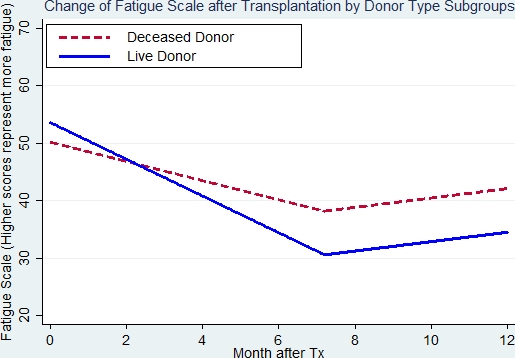Changes in Fatigue After Kidney Transplantation.
Surgery, Johns Hopkins School of Medicine, Baltimore, MD.
Meeting: 2016 American Transplant Congress
Abstract number: C267
Keywords: Kidney transplantation, Morbidity, Quality of life, Risk factors
Session Information
Session Name: Poster Session C: Poster Session 1: Kidney Complications-Other
Session Type: Poster Session
Date: Monday, June 13, 2016
Session Time: 6:00pm-7:00pm
 Presentation Time: 6:00pm-7:00pm
Presentation Time: 6:00pm-7:00pm
Location: Halls C&D
Previous research suggests that 60 to 97% of patients on dialysis experience fatigue, or a feeling of persistent tiredness or exhaustion. ESRD patients with fatigue are at higher risk of cardiovascular disease and mortality. We hypothesized that after transplantation the restoration of renal function will improve fatigue. Yet it is unclear how long it will take after KT for a patient to feel improvements in fatigue.
Methods: 213 participants were enrolled at the time of transplantation (5/2014-7/2015), and followed post-KT. Self-reported fatigue scale was measured at KT and follow-up using a standardized Kidney Disease Quality of Life Short Form (KDQOL-SFtm). The Scale of Energy/Fatigue was derived from 4 questions asking for patients' feeling of tiredness and exhaustion, and then re-scaled to a range of 0-100 points (with 0 being no fatigue and 100 being complete fatigue). Multilevel generalized linear models were used to obtain the fatigue change rate after adjusting for age, race, gender, donor type, frailty and dialysis status.
Results: The mean fatigue score was 48.3 (SD=23.6) at KT. It decreased to 41.5 (SD=22.5) at 3 months and 38.1 (SD=22.0) at 6 months post-transplantation (p=0.039). Fatigue improved in the first 7 months (0.6 year) after KT at an overall rate of 29.2 points/year (p<0.001; 95% CI, 17.0 to 41.4), and then stabilized. Live donor recipients tended to have faster improvements, at 38.2 points/year (p<0.001; 95% CI, 23.2 to 53.3), while deceased donor recipients only recovered at the speed of 20.0 points/year (p=0.01; 95% CI, 5.0 to 35.1). 
Conclusion: Fatigue is common in adults undergoing KT but improves over the first 7 months after transplantation. Additionally, live donor recipients tend to improve their fatigue scores faster than deceased donor recipients.
CITATION INFORMATION: Ying H, Olorundare I, Dagher N, Lonze B, Montgomery R, McAdams-Demarco M, Segev D. Changes in Fatigue After Kidney Transplantation. Am J Transplant. 2016;16 (suppl 3).
To cite this abstract in AMA style:
Ying H, Olorundare I, Dagher N, Lonze B, Montgomery R, McAdams-Demarco M, Segev D. Changes in Fatigue After Kidney Transplantation. [abstract]. Am J Transplant. 2016; 16 (suppl 3). https://atcmeetingabstracts.com/abstract/changes-in-fatigue-after-kidney-transplantation/. Accessed January 1, 2026.« Back to 2016 American Transplant Congress
